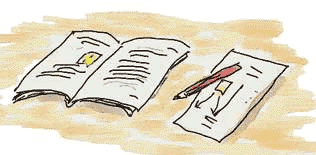 “Please read pages 127 to 150 about the development of the Roman Empire. We will discuss this chapter in the next class,” said the history teacher at the end of class while slamming his book shut. He gave a friendly nod to his pupils and left the classroom.
“Please read pages 127 to 150 about the development of the Roman Empire. We will discuss this chapter in the next class,” said the history teacher at the end of class while slamming his book shut. He gave a friendly nod to his pupils and left the classroom.
“Awww,” groaned Alex, “so many pages to read again!”
“I need at least two hours to read it”, agreed Christian and thought about how he could avoid his homework. “Maybe I’ll find something in the internet!”
Christian’s mother asked about his homework after lunch. He answered, “Nothing really, only some reading.”
He brought out his history book, searched for page 127 and began to read. As the story didn’t particularly interest him, he skimmed over the pages and finished reading after a half hour.
“Already finished?” asked his mother.
“Yes”, answered Christian and shoved his textbook in his schoolbag.
“What have you read?” persisted his mother.
“Oh, only something about the Romans!”
“Ok then, what have you learnt about them?”
“Caesar in the Senate had …”, he faltered at this point. “No, he first in two … or was it three campaigns … ?”
“You don’t remember very much”, chided his mother. “Have you made some notes?”
“But we only need to read a few pages!”
“To read properly you always need to make at least a few notes about what you are reading!”
![]() In school, in university, and also later when working, one must learn how to acquire knowledge from reading books. Many people believe that they will succeed to memorize the content of a text through repetitive reading. However, this method works only to a certain degree and only for very short passages. The problem at the same time is that the content quickly fades and after a few hours and days the read material has again vanished. Most scientists, who should be reading professionals, adopt two main types of reading as this activity belongs to the most important in their professional daily routine.
In school, in university, and also later when working, one must learn how to acquire knowledge from reading books. Many people believe that they will succeed to memorize the content of a text through repetitive reading. However, this method works only to a certain degree and only for very short passages. The problem at the same time is that the content quickly fades and after a few hours and days the read material has again vanished. Most scientists, who should be reading professionals, adopt two main types of reading as this activity belongs to the most important in their professional daily routine.
The quick browse is a fast and brief read to gain a quick understanding without deeply penetrating a text. It helps to gain a short overview of the content of a book or a chapter. You experience what the author writes about. It’s clear that you don’t notice too much, however, reading professionals at least note the author, title and a few key words in their workbooks, file cards or in their electronic databanks. The information may be needed later. Thus, this type of reading is only useful as initial information, and can be good preparation for the second type of reading.
Reading to learn or study depends upon understanding the content of a text as precisely as possible and to know afterwards what was contained in the text. With this type of reading, you should be able to reproduce the content of the text in your own words, for example at an examination or a lecture.
Professionals use various tricks for this type of reading.
- The most important is to write out the text. Most people retain the content in short sentences or also by using key words. They write separate notes on single-sided sheets that are then stored in a folder.
- They write in the margin of their excerpt – as called by the reading experts – on what page in the text the summary is found, in order to be able to later reference when they review or search details contained in the original text.
- With practice (the excerpts should also be practiced) the notes will become clearer, in order to later quickly find the key points. Reading experts sometimes use coloured pens, sketches, synopses and small tables.
- Experience has shown that the first excerpts are too long, as one “sticks” to the original text and don’t trust themselves to select their own formulations. You must first learn to separate the important from the unimportant material. However, reading experts have also begun similarly and often make a second shorter excerpt from an extensive first draft.
- If this method is applied as preparation for later learning, then one can construct
 their excerpt as questions and answers.
their excerpt as questions and answers.
An important side effect of this type of professional reading is that you always have a visible result of your work that can be shown to others.
